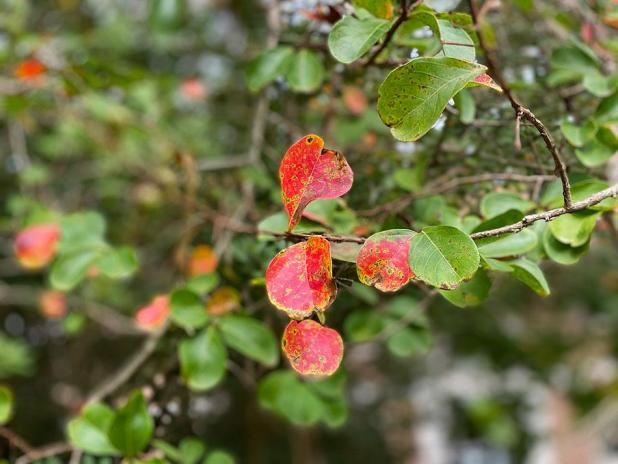
Cercospora leaf spot causes leaves to turn yellow, orange and red, then fall from the tree as if it were autumn.
—LSU AgCenter/Heather Kirk-Ballard
Get It Growing: Spots, dots appear on leaves
It’s a sign of the times: spots and dots appearing before our very eyes, seemingly overnight. No, it’s not your vision failing you, and there’s no need to clean your glasses. We’re dealing with something that’s been lurking for the right time to show itself.
I thought we might have escaped it this year thanks to our drier-than-normal start to summer. But as soon as the daily showers returned, so did the spots and dots. I’m referring to the annual appearance of Cercospora leaf spot on hydrangeas and crape myrtles.
Cercospora is a genus of fungi that includes many plant pathogenic species causing foliar leaf spots and blights. Two we see each year are leaf spot of hydrangea and crape myrtle. Not-so-luckily for us, warm, moist environments are perfect for disease development.
Hydrangea leaf spot shows up after periods of continuous wet conditions. It can be caused by rainfall and excessive overhead irrigation. Spots typically appear on lower leaves first. These are 1/8-to-1/4-inch-diameter spots with pale or light brown centers and dark margins. The disease progresses to the upper leaves and, in severe cases, causes defoliation. Fortunately, the disease rarely, if ever, kills the plant. Most cases are mild and cause unsightly foliage. Spots on oakleaf hydrangeas tend to appear more angular in shape instead of round, with a dark brown to purple color.
Typically, fungicide sprays are not necessary. Good gardening practices will help minimize the spread of the disease. This includes removing diseased leaves from the plants, removing fallen leaves from around the plants and not using overhead irrigation. Make sure to discard diseased leaves in the trash and not in the compost pile.
In years of excessive rainfall and severe infections, chemical control may be warranted to help control the disease. Using fungicides containing chlorothanil is recommended. These include products such as Bonide Fung-onil, Ortho MAX Disease Garden Control and Daconil. Fungicides will not cure disease symptoms, so removal of the damaged foliage is still important to help control spread.
On crape myrtles, Cercospora leaf spot becomes noticeable whenever the trees start showing fall color in the summertime. Leaves turn yellow, orange and red, then fall from the tree. This begins with yellow-to-brown, 1/8-to-¼-inch spots on the leaves. Infected leaves then develop what looks like premature fall color and drop from the tree. Severe infections can cause complete defoliation of trees. This is dependent on how much rainfall we receive. Periods of excessive rainfall tend to increase disease incidence and severity.
Thankfully, this is not fatal to crape myrtles, but it can stunt the plants’ growth. As with hydrangea leaf spot, good cultural practices can minimize disease development and spread. Before planting, consider the location and spacing. Planting in full-sun locations and not overcrowding plantings will allow good air flow to help dry excessive moisture quicker. Raking and disposing of diseased leaves in the trash will reduce the inoculum source for future infections.
Treatment with fungicide sprays would need to begin in the early summer and continue with regular sprays to control the disease. If you choose to do this, use a fungicide such as Spectracide Immunox or Ferti-lome Liquid Systemic Fungicide II. Spraying late in the summer after the disease is widespread is not very effective.
While these two leaf spot diseases may cause your hydrangea and crape myrtle foliage to look unsightly, thankfully the plants will survive. Most of our landscapes are struggling with the heat and humidity this time of the year. Just wait. Surely fall weather is just around the corner — right?
